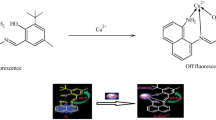Abstract
4,4-Difluoro-4-bora-3a,4a-diaza-s-indacene (BODIPY) is a well-known fluorophore, with a high molar extinction coefficient and high fluorescence quantum efficiency (Φfl). Furthermore, its structure can be modified to change its excitation and emission wavelengths. However, little work has been done on the structural modification of fluorines at the B-4 position with other functional groups. We synthesized 4-methoxy-substituted BODIPY derivatives in satisfactory yields, and found that they exhibited improved solubility in aqueous solution. Moreover, their oxidation and reduction potentials were greatly decreased without any change in their absorbance and fluorescence properties. These features of 4-substituted BODIPYs may be useful for developing novel fluorescence probes based on the intramolecular photoinduced electron transfer (PeT) mechanism, because it is possible to optimize the PeT process precisely by modulating the electrochemical properties of the fluorophore. The value of this approach is exemplified by its application to the development of a highly sensitive and pH-independent fluorescence probe for nitric oxide.








Similar content being viewed by others
References
Grynkiewicz G, Poenie M, Tsien RY (1985) J Biol Chem 260:3440–3450
Minta A, Kao JPY, Tsien RY (1989) J Biol Chem 264:8171–8178
Zalewski PD, Forbes IJ, Betts WH (1993) Biochem J 296:403–408
de Silva AP, Gunaratne HQN, Gunnlaugsson T, Huxley AJM, McCoy CP, Rademacher JT, Rice TE (1997) Chem Rev 97:1515–1566
Tanaka K, Miura T, Umezawa N, Urano Y, Kikuchi K, Higuchi T, Nagano T (2001) J Am Chem Soc 123:2530–2536
Kojima H, Nakatsubo N, Kikuchi K, Kawahara S, Kirino Y, Nagoshi H, Hirata Y, Nagano T (1998) Anal Chem 70:2446–2453
Gabe Y, Urano Y, Kikuchi K, Kojima H, Nagano T (2004) J Am Chem Soc 126:3357–3367
Ueno T, Urano Y, Setsukinai K, Takakusa H, Kojima H, Kikuchi K, Ohkubo K, Fukuzumi S, Nagano T (2004) J Am Chem Soc 126:14079–14085
Urano Y, Kamiya M, Kanda K, Ueno T, Hirose K, Nagano T (2005) J Am Chem Soc 127:4888–4894
Karolin J, Johansson LBA, Strandberg L, Ny T (1994) J Am Chem Soc 116:7801–7806
Haugland RP (2005) The handbook: a guide to fluorescent probes and labeling technologies (10th edn). Molecular Probes Inc., Eugene, OR
Burghart A, Kim H, Welch MB, Thoresen LH, Reibenspies J, Burgess K, Bergström F, Johansson LBA (1999) J Org Chem 64:7813–7819
Chen J, Burghart A, Kovacs AD, Burgess K (2000) J Org Chem 65:2900–2906
Rurack K, Kollmannsberger M, Daub J (2001) New J Chem 25:289–292
Shen Z, Röhr H, Rurack K, Uno H, Spieles M, Schulz B, Reck G, Ono N (2004) Chem Eur J 10:4853–4871
Kollmannsberger M, Rurack K, Resch-Genger U, Daub J (1998) J Phys Chem A 102:10211–10220
Goze C, Ulrich G, Charbonnière L, Cesario M, Prangé T, Ziessel R (2003) Chem Eur J 9:3748–55
Koutaka H, Kosuge J, Fukasaku N, Hirano T, Kikuchi K, Urano Y, Kojima H, Nagano T (2004) Chem Pharm Bull 52:700–703
Baruah M, Qin W, Vallée RAL, Beljonne D, Rohand T, Dehaen W, Boens N (2005) Org Lett 7:4377–4380
Wu Y, Peng X, Guo B, Fan J, Zhang Z, Wang J, Cui A, Gao Y (2005) Org Biomol Chem 3:1387–1392
Yamada K, Nomura Y, Citterio D, Iwasawa N, Suzuki K (2005) J Am Chem Soc 127:6956–6957
Coskun A, Akkaya EU (2005) J Am Chem Soc 127:10464–10465
Wang P, Giese RW (1998) J Chromatogr A 809:211–218
Kim H, Burghart A, Welch MB, Reibenspies J, Burgess K (1999) Chem Commun 1889–1890
Ulrich G, Goze C, Guardigli M, Roda A, Ziessel R (2005) Angew Chem Int Ed 44:3694–3698
Kee HL, Kirmaier C, Yu LH, Thamyongkit P, Youngblood WJ, Calder ME, Ramos L, Noll BC, Bocian DF, Scheidt WR, Birge RR, Lindsey JS, Holten D (2005) J Phys Chem B 109:20433–20443
Hrabie JA, Klose JR, Wink DA, Keefer LK (1993) J Org Chem 58:1472–1476
Paeker A, Rees WT (1960) Analyst 85:587–600
Miura T, Urano Y, Tanaka K, Nagano T, Ohkubo K, Fukuzumi S (2003) J Am Chem Soc 125:8666–8671
Rehm D, Weller A (1970) Isr J Chem 8:259–271
Palmer RMJ, Ferrige AG, Moncada S (1987) Nature 327:524–526
Moncada S, Higgs AN (1993) Engl J Med 329:2002–2012
Snyder SH, Bredt DS (1992) Sci Am 266:68–77
Nathan C, Xie Q (1994) Cell 78:915–918
Kojima H, Sakurai K, Kikuchi K, Kawahara S, Kirino Y, Nagoshi H, Hirata Y, Akaike T, Maeda H, Nagano T (1997) Biol Pharm Bull 20:1229–1232
Acknowledgements
This study was supported in part by a Grant-in-Aid for Creative Scientific Research (No. 13NP0401), research grants (Grant Nos. 14103018, 16651106, and 16689002 to Y.U.), and a grant for the Advanced and Innovational Research Program in Life Sciences to T.N. from the Ministry of Education, Culture, Sports, Science, and Technology of the Japanese Government, and a grant from the Kato Memorial Bioscience Foundation to Y.U.
Electronic supplementary material
Detailed descriptions of synthetic procedures for all compounds are given in the electronic supplementary material available online.
Author information
Authors and Affiliations
Corresponding author
Additional information
Yu Gabe and Tasuku Ueno contributed equally to this work.
Electronic supplementary material
Below are the links to the electronic supplementary material.
Rights and permissions
About this article
Cite this article
Gabe, Y., Ueno, T., Urano, Y. et al. Tunable design strategy for fluorescence probes based on 4-substituted BODIPY chromophore: improvement of highly sensitive fluorescence probe for nitric oxide. Anal Bioanal Chem 386, 621–626 (2006). https://doi.org/10.1007/s00216-006-0587-y
Received:
Revised:
Accepted:
Published:
Issue Date:
DOI: https://doi.org/10.1007/s00216-006-0587-y




